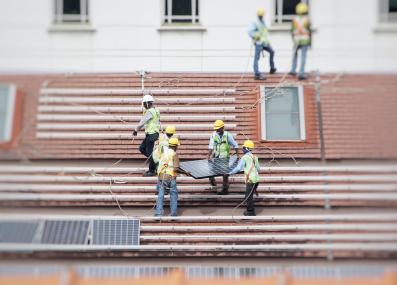Have a question?
Will mining the resources needed for clean energy cause problems for the environment?
Almost all mining—including for the clean tech sector—damages ecosystems and communities. Water contamination and scarcity, and the resulting social conflicts, are key concerns as clean energy grows.
July 21, 2022
Clean energy technologies, from wind and solar to hybrid and electric vehicles, help us slow down climate change, but they’re not inherently perfect. Currently, they rely on critical minerals that are environmentally costly to mine. You’ve probably heard of some: lithium, copper, graphite, zinc, cobalt, copper, and nickel all make the list, alongside rare earth elements derived from mineral compounds.
And these decarbonization technologies require more of these resources than their fossil fuel-based equivalents. Electric cars, for example, need six times the amount of these minerals compared to gas-powered vehicles, and onshore wind plants need nine-fold more than gas-fired plants.1 (Hydropower, biomass and nuclear energy technologies have “comparatively low mineral requirements,” according to the International Energy Agency.)
Extracting these minerals also requires energy and freshwater, and produces greenhouse gas emissions and waste. Mining can be dangerous for workers and, in certain places, is tied to labor and human rights abuses. Surrounding communities, often in low-income or developing areas, disproportionately shoulder these burdens, leading to a tangle of land-use and environmental justice conflicts.
Scott Odell, a postdoctoral associate at the MIT Environmental Solutions Initiative who studies mining, climate change, and socio-environmental conflict, says that pinpointing the worst harms is tough, but land-use change and freshwater contamination and scarcity are major concerns.
More than 80% of mining areas worldwide target materials critical to renewable energy production.2 Processing ore, transporting it in slurry pipelines, and suppressing mine dust require water, often from regions where water is already scarce. Chile’s Atacama desert, “where I do my work, is the driest desert on Earth,” Odell says. “It's also one of the world's most important sites for copper extraction.”
And mining companies don’t just drain local water sources; they can contaminate clean supplies, too.
That’s because mineral mining makes mountains of waste. In the U.S., copper mining makes up the largest percentage of metal mining and processing waste.3 Some waste storage piles can be as large as 1,000 acres. Waste is typically stored in isolated areas called tailing ponds, Odell explains, which sometimes fail (especially in the face of natural hazards like floods and earthquakes), sending toxins into nearby water systems. One Associated Press report from 2019 found that more than 50 million gallons of contaminated wastewater from U.S. mines flow into local water sources every day.4
Mining also damages natural resources in other ways by polluting the air with greenhouse gas emissions and toxic aerosols, driving deforestation worldwide,5 and threatening biodiversity,2 sometimes in protected areas. For nearby communities, environmental damage from mining can lead to health problems,6 including cancers7 and respiratory diseases; poisoned fish8 and crops;9 and long-lasting, sometimes violent land use conflicts.10
Reducing the sector’s environmental and social footprint means adopting improved regulations and lower-impact methods, Odell says. This can be done, for example, by improving community consultation processes, ensuring comprehensive mine closure and remediation of abandoned mine sites, and exploring ways to reduce or reuse11 mining waste.
Affected communities and environmental groups are fighting for greater industry accountability and stricter, better-enforced regulations. And, Odell says, a growing number of mining companies are making better efforts to ease tensions by collaborating with communities and, for example, investing in desalination tech that allows miners to pull water from the ocean instead of local freshwater supplies.
Raising awareness about these issues can also help push the industry in a positive direction. “We need to respond to climate change and we’re doing that by transitioning to clean energy,” Odell says. “But we need to recognize that producing clean energy has its own environmental and social impacts that we need to fix concurrently.”
1 International Energy Agency: "The Role of Critical Minerals in Clean Energy Transitions." Updated March 2022.
2 Sonter, L.J., Dade, M.C., Watson, J.E.M. et al. "Renewable energy production will exacerbate mining threats to biodiversity." Nature Communications, Vol. 11, 4174 (2020). doi:10.1038/s41467-020-17928-5
3 U.S. Environmental Protection Agency: Copper Mining and Production Wastes. Accessed July 21, 2022.
4 Associated Press: "50m gallons of polluted water pours daily from U.S. mine sites." Matthew Brown, February 2020, 2019.
5 Caballero Espejo, Jorge, Max Messinger, Francisco Román-Dañobeytia, Cesar Ascorra, Luis E. Fernandez, and Miles Silman. "Deforestation and Forest Degradation Due to Gold Mining in the Peruvian Amazon: A 34-Year Perspective." Remote Sensing 10, no. 12 (2018). doi:10.3390/rs10121903
6 Washington Post: "The cobalt pipeline: Tracing the path from deadly hand-dug mines in Congo to consumers' phones and laptops." Todd C. Frankel, September 30, 2016.
7 The Guardian: "'We are afraid': Erin Brokovich pollutant linked to global electric car boom." Febriana Firdaus and Tom Levitt, February 19, 2022.
8 Mongabay: "Red seas and no fish: Nickel mining takes its toll on Indonesia's spice islands." Rabul Sawal, February 16, 2022.
9 Ziqi Zhou, Zhizhong Chen, Hanjiang Pan, Binbin Sun, Daoming Zeng, Ling He, Rong Yang, Guohua Zhou. "Cadmium contamination in soils and crops in four mining areas, China." Journal of Geochemical Exploration, Volume 192,
2018. doi:10.1016/j.gexplo.2018.06.003
10 Gavin Hilson. "An overview of land use conflicts in mining communities." Land Use Policy, Volume 19, Issue 1, 2002. doi:10.1016/S0264-8377(01)00043-6
11 Bernd G. Lottermoser. "Recycling, Reuse and Rehabilitation of Mine Wastes." Elements 7, 6 (2011). doi:10.2113/gselements.7.6.405








